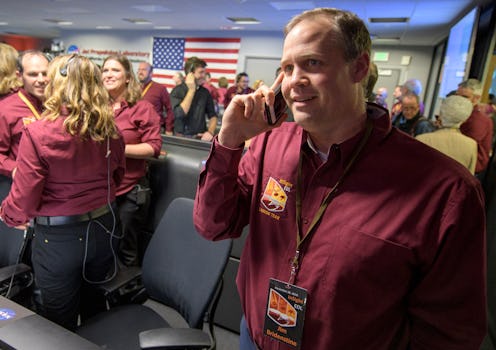News
How These NASA Members Celebrated InSight's Mars Landing Will Make Your Day

For anyone who's ever wondered what a room full of scientists celebrating a massive achievement looks like, you're in luck. On Monday afternoon, video of NASA reacting after InSight landed on Mars successfully has provided the most heartwarming answer to this question. Upon seeing that their special aircraft had successfully traveled 301 million miles to safely land on Mars, the room exploded with cheers, and one specific duo performed the secret handshake of the century.
The celebration occurred at Jet Propulsion Laboratory in Pasadena, California, at approximately three in the afternoon. Rob Manning, one of the chief engineers for the project, told NBC News, "This never gets old. What a relief. Fabulous, fabulous.”
That relief came immediately following the infamous "seven minutes of terror," a description coined by NASA to describe the final phase of a spacecraft's landing in which it has to safely decelerate from 12,300 miles per hour to five miles per hour upon landing.
Rob Grover, who was in charge of InSight's landing team, spoke to NBC prior to the landing, and said that there's a reason why NASA calls it the "seven minutes of terror."
"We can't joystick the landing, so we have to rely on the commands we pre-program into the spacecraft," Grover said. "We've spent years testing our plans, learning from other Mars landings and studying all the conditions Mars can throw at us."
InSight did settle into its new home quite nicely. Then the celebrations began.
Now that InSight has landed safely, though, the work has only just begun.
'InSight' is short for the project's full name, the "Interior Exploration using Seismic Investigations, Geodesy and Heat Transport." The goal of this mission is for NASA to look beneath Mars' surface and collect information about the crust and mantle of the planet. InSight is even equipped with the capacity to dig 16 feet into the planet to gain as much information as possible. And yes, the goal of this mission is, in part, to better understand whether Mars could have supported life in the past (or potentially whether it could support life in the future.)
In addition, the InSight lander is also searching to use the data collected to help scientists better understand how planets were formed billions of years ago.
The cost of this project wasn't nothing: the current estimated mission cost is $850 million, which covers the next two years of data collection—which, confusingly enough, will actually only be one year for Mars' time.
Jim Green, one of NASA's chief scientists, explained to NBC News that the project's goal and parameters could totally change in the years, pending what data is collected. "It could last a couple more years and answer questions that maybe we haven't even thought of yet," Green said. "How cool is that?"
Unfortunately, it's not likely for any information to be released from InSight in the immediate future. For now, science fanatics across the world will have to settle for updates from the NASA Twitter account, which has already shared the first photo that InSight took from Mars.